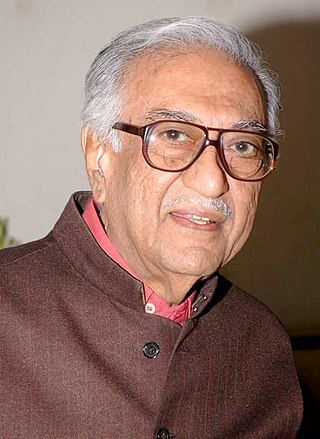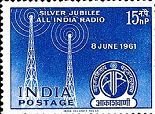
Radio Mirchi, also known as 98.3 Mirchi, is a nationwide network of private FM radio stations in India. It is owned by the EntertainmentNetwork India Ltd (ENIL), which is one of the subsidiaries of The Times Group. The tagline of Radio Mirchi is "Mirchi Sunnewaale Always Khush!". It is the first privately owned radio station in India.
The television industry in India is very diverse and produces thousands of programs in many Indian languages. More than half of all Indian households own a television. As of 2016, the country had over 900 channels of which 184 were pay channels. National channels operate in Hindi and English, in addition to channels in several other languages including Telugu, Tamil, Kannada, Malayalam, Bengali, Marathi, Odia, Punjabi, Assamese, Gujarati, Urdu, Bhojpuri, Kashmiri, Konkani and Haryanvi, among others. The Hindi, Telugu and Tamil language television industries are by far the largest television industries in India.
Arts and architecture in India have had their course shaped by a synthesis of indigenous and foreign influences that have consequently shaped the course of the arts of the rest of Asia, since ancient times. Arts refer to paintings, architecture, literature, music, dance, languages and cinema. In early India, most of the arts were derived Vedic influences. After the birth of contemporary Hinduism, Jainism, Buddhism, and Sikhism arts flourished under the patronage of kings and emperors. The coming of Islam spawned a whole new era of Indian architecture and art. Finally the British brought their own Gothic and Roman influences and fused it with the Indian style. They have a culture infusion in their art.
AIR FM Gold is an FM radio channel in Mumbai, Delhi, Kolkata and Chennai, India. It is run by the All India Radio, a government owned enterprise, a division of Prasar Bharati. In Mumbai, it features Hindi songs, and English songs along with hourly news in English and Hindi. It operates on 100.1 in Mumbai and on 100.1 Megahertz in Delhi. It was started on 15 August 2001 by the then Minister of Information & Broadcasting.
AIR FM Rainbow is a group of FM radio channels across India. The group of stations was previously called FM Metro, but the name was changed to FM Rainbow in 2002. The group is run by All India Radio, or AIR, a government owned enterprise. It features Hindi and regional language songs, while also playing English music and providing hourly news in English, regional language and/or Hindi. In Bhopal, FM Rainbow broadcasts in Hindi to more than 12 districts of Madhya Pradesh and 21 Bhopal City suburbs. AIR FM Rainbow Delhi airs in as many as ten cities, more than any of the other FM Rainbow frequencies. Mumbai, Lucknow, Vizag, Hyderabad, Vijayawada, Kakinada, Kochi and Bangalore all receive FM Rainbow transmissions on a variety of frequencies.
DD Free Dish is an Indian free-to-air satellite television provider owned and operated by Public Service Broadcaster Prasar Bharati. It was launched in December, 2004. In March 2022, It has a reach of over 43 million households which is more than 25% of the total TV households in the country. DD Free Dish earns by selling slots to private broadcasters through Online auction.

Ameen Sayani was an Indian radio announcer. He achieved fame and popularity across the Indian subcontinent when he presented his Binaca Geetmala program of hits over the airwaves of Radio Ceylon. He was one of the most imitated announcers. His style of addressing the audience with "Behno aur Bhaiyo " as against the traditional "Bhaiyo aur Behno" is still treated as an announcement with a melodious touch. He had produced, compered over 54,000 radio programmes and 19,000 spots/jingles since 1951.
The FM broadcasting in India began in 1977, but boomed after 2001 when the privatisation of FM broadcasting began. AIR's FM LRS was inaugurated on 1 July 2000 at 06:00 hours in Kodaikanal relaying Madurai programs in the frequency 100.5 MHz. 100.5 was so popular that LRS was upgraded to an FM Channel in just two months. The channel covered a radius of about 200km due to its location at 2200 meters above MSL at Kodaikanal. KODAI FM is popularly known as it is the biggest individual FM channel in India, in both area coverage and listenership.

Media in Goa refers to the newspapers, magazines, radio stations, cable and television networks and online media in India's smallest state. Over the past two-and-half decades, the Goa-linked online media has also grown.
The Vividh Bharati Service of All India Radio was conceptualized to combat Radio Ceylon in 1967. Due to the Indian Government stopping its short wave relay centers, VBS is only available on the Internet. Vividh Bharati radio channel was launched on 3 October 1957.
Hyderabad, in India, has a well-developed communication and media infrastructure, and the city is covered by a large network of optical fiber cables. The city's telephone system is serviced by four landline companies: BSNL, Tata Indicom, Reliance and Airtel. There are a number of mobile-phone companies: Aircel, BSNL, Airtel, Hutch Idea Cellular, Uninor, MTS, Virgin Mobile, Tata Indicom, Tata DoCoMo and Reliance. Several companies offer broadband internet access.

Zulfiqar Ali Bukhari often abbreviated as Z. A. Bukhari was a broadcaster of British India and later Pakistan. He was also a writer, poet and musician. He was the first director-general of Radio Pakistan.
Telugu-language radio was first broadcast from AIR Chennai, Egmore on 16 June 1938 at 8:15 pm when the Madras state Prime Minister Kurma Venkata Reddy Naidu and Chief Minister C. Rajagopalachari delivered inaugural speeches. In 1933 a 200 W radio station started by postal employee Mahbub Ali had gone on-air from Hyderabad, but in 1935 the Nizam of Hyderabad took control of it, and most programs were broadcast in Urdu. In July 1939 it was renamed as Deccan Radio, and on 1 April 1950 the Government of India took control from the Nizam and operated it as Akashavani. AIR Vijayawada started on 1 December 1948.

All India Radio Srinagar is a public radio station operating in Srinagar, Jammu and Kashmir, India. All India Radio Srinagar broadcasts in Kashmiri, Urdu and Hindi languages. Formerly known as Radio Kashmir Srinagar, it was renamed as AIR Srinagar following the Jammu and Kashmir Reorganisation Act, 2019. It is one of public stations in the union territory alongside AIR Jammu and AIR Leh. All India Radio Jammu broadcasts in Dogri, Urdu and Hindi languages.
Munish Jolly is an Indian former cricketer. He played first-class match for Bengal in 1997/98. He is in the top panel of Commentators of All India Radio and is a leading Broadcaster, Voice-over artist. He had the honour of covering Rio 2016 and Tokyo 2020 Olympics with Star Sports and Sony Sports Network, respectively. He has delivered commentary in Cricket World Cups, Hockey World Cups, the Prestigious National Sports Award at the Durbar Hall in the Rashtrapati Bhavan, New Delhi. He was chosen to do live commentary of swearing-in-ceremony of Honourable President of India in 2017 for All India Radio. He is also a Radio Jockey with FM Rainbow Delhi. He was part of the chosen panel of anchors to present the Commemoration Ceremony of India's first National War Memorial, Delhi on 25 February 2019, graced by the honourable Prime Minister of India, Sh. Narendra Modi.
Broadcasting in the city of Chennai began in 1924 by the Madras Presidency Radio Club. The service was operational till the government-run All India Radio started broadcasting in the city in 1938.
Radio broadcasting began in India in 1922. The Government owned radio station All India Radio dominated broadcasting since 1936 but through privatization and deregulation has allowed commercial privately owned talk and music stations to reach large audiences.
Vijayawada, in India, has a well-developed communication and media infrastructure. It has a basic network of optical fiber cables. The city's telephone system is serviced by four landline companies: BSNL, Tata Indicom, Reliance and Airtel. There are a number of mobile-phone companies: Aircel, BSNL, Airtel, Uninor, MTS, Tata Indicom, Tata Docomo and Jio. Several companies offer broadband internet access.













